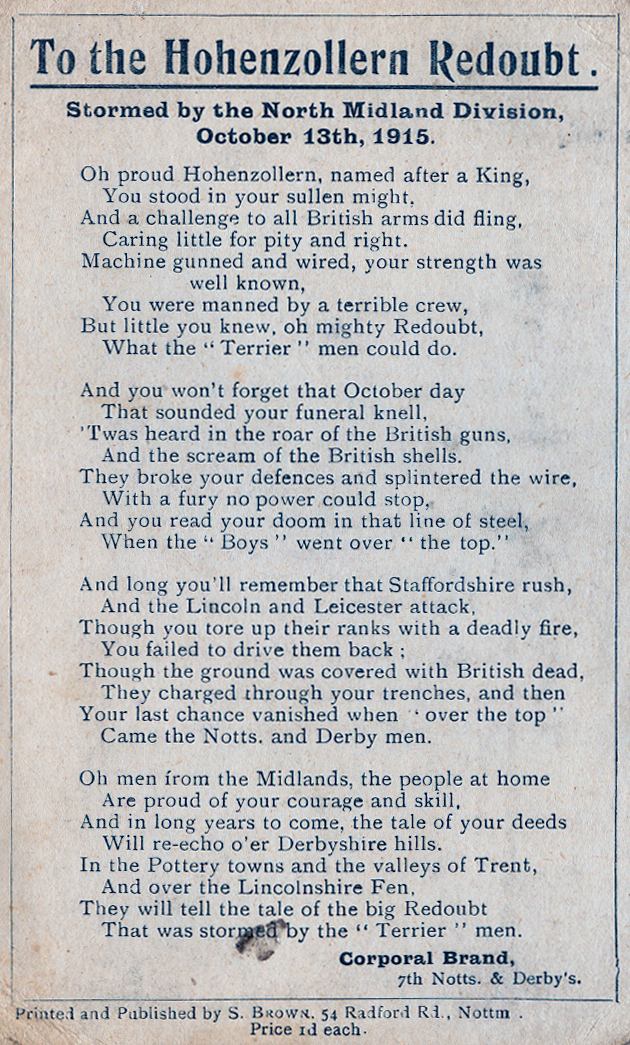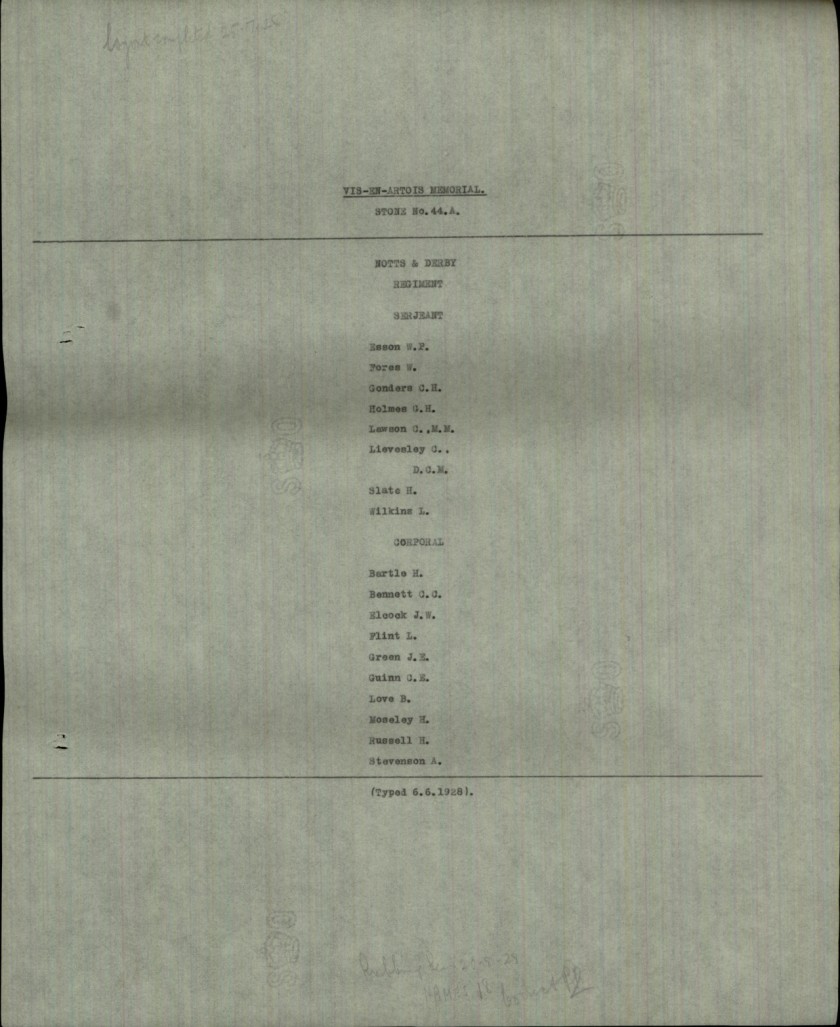Charles Lievesley was born in Whittington on 15th August 1890. According to the 1891 census he was the sixth child of William John Lievesley and Sarah (born Brammer).
Charles was baptised at Old Whittington Church in September 1890.

Charles’s entry is near the bottom which is very difficult to read. It does show that the family were living at Sheepbridge at the time of the Baptism and Charles’s father was a Wagon Inspector.
By the census of 1891 the family were living at 15 Prospect Road Old Whittington.

I would assume that William worked at the Wagon Works at Whittington. As you can see from the map Chatsworth Wagon works were not far from Prospect road.

The Wagon works were owned by Hurst, Nelson and Co, a company based in Motherwell Scotland the Advertising Poster shows Chatsworth Wagon Works is listed as one of the Branch Works.

Advert taken from Graces Guide to British Industrial England
Charles started school at Websters Endowed school (mixed) on 22nd October 1894 he was only there until 11th March 1895 when he left to go to the Brushes School.

In 1901 the family were still living at Prospect Road but now at number 11. Charles is not the youngest child any longer he now has two younger brothers. Herbert, 8, Frank, 6.
His older brother Harry has left home and in 1903 Harry married Gertrude Lewis in Sheffield and by 1911 the couple had two children and were living at Firth Park in Sheffield.

As you can see from the 1911 census Charles’s father William has now retired through ill health and Charles’s brother Walter is a widower. Walter married Edith Alice Roberts on 19th December 1904 at Old Whittington Parish Church. Sadly, Edith died in January 1907 aged just 24 years old. Albert and Horace (listed as grandsons on the census) are Walter and Edith’s sons. Happier times were ahead for Walter when on April 15th, 1922 he married Emily Bates at Old Whittington Church.
In 1911 Charles was working as a pottery labourer at Pearson’s Pottery (the history of Pearson Pottery can be read at http://www.oldminer.co.uk/pottery.html).

Advert taken from Grace’s Guide to British Industrial England
Charles enlisted in Chesterfield in the 1/6th Battalion Notts and Derbyshire Regiment on 17th October 1914 as his Attestation Form shows, Service number 2938.

Charles was 23 years and 2 months when he enlisted. The description form completed on enlistment states that he was 5 feet 6 1/2 inches weighed 126 lbs, with a fair complexion, grey eyes and fair hair.

Charles joined up for the Territorial Force which was designed for Home Defence. However, soldiers could volunteer for Imperial Service which meant they could then, in times of war, be called into action overseas. Charles did volunteer and would be entitled to wear the Imperial Service Badge.


Sherwood Foresters Cap Badge
© IWM. Original Source: http://www.iwm.org.uk/collections/item/object/30076320
Charles’s signed form to confirm he would be willing to serve overseas in the event of ‘National Emergency’.

Charles was promoted twice during his time in the Army. He was attested 17th October 1914 and was made a Private. He was promoted, without pay, to a Lance Corporal on 25th January 1917, then appointed paid 29th May 1917. He was promoted to Corporal 1st June 1917. The Service record is very difficult to read but by the time he was killed Charles was a Sergeant and his Service number was 240810. The Sergeant was an important figure in the ranks and was the senior non-commissioned rank in charge of a Platoon in an Infantry Battalion, the Lieutenant or Second Lieutenant would be in overall charge of the platoon.

According to Charles’s medal card he arrived in France on 25th February 1915, this is the recorded date that the whole battalion first arrived in France, according to his Military History Sheet it would appear that he went over in February 1915 and never returned to Whittington at all!


The 1/6th Battalion became part of the 139th Brigade in the 46th (North Midland) Division during May 1915. Their list of battles–
The German liquid fire attack at Hooge (30-31 July 1915). On July 30, 1915, the Germans put their new weapon, the flammenwerfer, or flamethrower, to devastating use against the Allies at the Battle of Hooge. More can be read about this battle at https://www.history.com/this-day-in-history/battle-of-hooge
The attack at the Hohenzollern Redoubt. On 13 October 1915, the 46th (North Midland) Division launched an attack after gas had been released. The division suffered heavily, with 3,763 casualties. More can be read at https://britainatwar.keypublishing.com/2017/10/02/the-hohenzollern-redoubt/
This poem was written by Corporal Brand 7th Notts and Derbyshire.
I think it’s a fitting tribute to all the men who took part in this battle. I cannot say for definite if Charles did take part but he must have lost many friends on that day.

Poem taken from https://derbyshireterritorials.files.wordpress.com/2013/11/hohenzollern-poem-brand.jpg
On 23 December 1915 the Division was ordered to proceed to Egypt, most units reached Egypt via Marseilles by 13 January.
1916 After just a few days in Egypt, the move of the Division was countermanded and the units were returned to France. The Division remained in France and Flanders for the rest of the war, taking part in the following engagements:
The diversionary attack at Gommecourt (1 July 1916)
1917 Operations on the Ancre (March)
Occupation of the Gommecourt defences (4 March)
The attack on Rettemoy Graben (12 March)
The German retreat to the Hindenburg Line
The attack on Lievin (1 July)
The Battle of Hill 70 (15-25 August)
1918
The Battle of the St Quentin canal, including the passage of the canal at Bellenglise.
The Special orders of the Day below show how well the Battle of the St Quentin canal went and the 46th (North Midland) Division in particular. Charles would have been part of this action.

There is no record to confirm which of these actions Charles took part in, but he would certainly have taken part in some of them. He served nearly four years in the Army but was sadly killed on 3rd October 1918. The Special Order of the Day by Major General Boyd, Commander of 46th Division indicates that they were involved in quite a Battle on 3rd October1918, and I imagine Charles Lievesley, as a Sergeant, would have been in the thick of it.

Charles had been put forward for the Distinguished Conduct Medal a few days before he died. This is awarded for gallantry in the field, a distinguished award for bravery for NCOs and soldiers of the British Army, second only to the Victoria Cross for other ranks. The citation for the award (taken from UK Citations of DCM 1914-1920 Notts and Derbys (Sherwood Foresters) Regiment) follows and shows Charles Lievesley to be very courageous leader of men.


Charles’s family was advised of his death and an entry in the Courier 19th October 1918 reads as follows.
Mrs. Lievesley Broomhill Park, Old Whittington, has received news from the officer commanding that her son Sergt. Charles Lievesley was killed in action early in the morning of 4th October. “He had fought bravely and gallantly throughout the previous day” the letter stated. “He had only just been awarded the D.C.M. for good work done on a previous occasion. His death is mourned by all his comrades, and I have lost one of the best of N.C.O.s” Twenty eight years of age, Sergt. Lievesley worked at Messrs. Pearson’s Pottery before joining up. He enlisted in October 1914, and went to France in February 1915 with the Territorial force.

The letter from his Commanding Officer states that Charles died on 4th October, however all the military records state that he died on 3rd October. I imagine it would be a very easy mistake to make on a battlefield! Charles’s body was never found and he is remembered on one of the Panels on the Vis-en-Artois Memorial.



Further details of the cemetery can be found at https://www.cwgc.org/find-a-cemetery/cemetery/79200/vis-en-artois-memorial/
Charles was also awarded the Victory and British War Medals and the 14/15 Star.
His belongings were sent on to his mother Sarah Lievesley but sadly the details on the record card are unreadable.
Charles is remembered on Old Whittington and the Brushes War Memorials and on the Sherwood Foresters Roll of Honour at http://www.the-sherwood-foresters.co.uk/l_names/lievesley_charles.html

